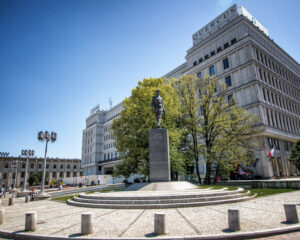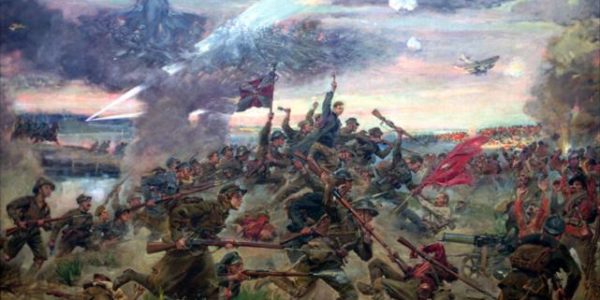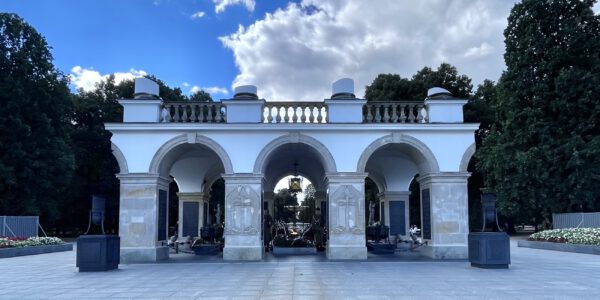Beata Bruggeman-Sekowska
photo: ©City of Warsaw
When visiting one of the most prominent locations of the capital of Poland, Warsaw, called Nowy Swiat you cannot miss the roundabout with a palm tree. It is called General Charles de Gaulle roundabout and nearby there is his statue. Why is the presence of General Charles de Gaulle who was the leader of the French resistance during the WWII and President of France from 1959 to 1969 so visible in the pivotal part of Polish capital?
Russia’s wish to spread revolution and dominate Europe
Poland (Second Polish Republic) regained its independence in 1918, after three partitions of Poland, (1772, 1793, 1795), by Russia, Prussia, and Austria. The size of Poland throughout the years was getting smaller and smaller until the final partition when the state of Poland ceased to exist. In 1795 Poland disappeared from the map of Europe for 123 years.
Vladimir Lenin together with Leon Trotsky, Joseph Stalin and Lev Kamenev had plans to spread the revolution to Germany and Western Europe. In order to reach this goal they had to conquer Central Europe and Poland. Stalin thought that it was an easy for his Red Army to conquer Poland. Bolsheviks formed their puppet governments in Belarus, Lithuania and Ukraine and in 1919 the Soviet-Polish war started.
French Military mission
France sent to Poland a French Military mission consisting of around 400 French officers to support Poland in the Polish-Soviet War (1919-1921) and to advise and help create a strong Polish army, improving its logistics and organisation that could serve as a strong ally against Germany. The French officers were cooperating with staff of Polish units at various levels. The French mission was commanded by General Paul Prosper Henrys and it was established in accordance with the wish of Polish Marshal Józef Piłsudski and French President Raymond Poincaré.
Charles de Gaulle was a member of the French Military Mission and he fought against the Bolsheviks. He arrived to Poland with General Haller’s Blue Army, which had been established in France in 1917. The name of the army came from the colour of its uniforms. It was the most numerous Polish military formation abroad during the First World War, which fought against the Germans in the Vosges and Champagne. General Jozef Haller’s Blue Army, which also fought in the Polish-Soviet War, was equipped by the French with 120 Renault FT-17 tanks.
De Gaulle served as an instructor at an Infantry School in Rembertów of Poland’s infantry and in Kutno. During his stay in Poland he lived near the roundabout at Nowy Swiat 15/17. As advisor he served during the war against Bolsheviks under the commandment of Rydz-Śmigły and Józef Piłsudski. De Gaulle was appointed major in 1920, just before the Battle of Warsaw.
In his diaries he described his service in Poland and expressed the courage of Polish soldiers in one of the battles of the Polish-Soviet war: “The offensive has started brilliantly. The manoeuvre group commanded by Head of State, Piłsudski, grouped between Ivanogorod22 and Chełm, is rapidly advancing northwards. The enemy, completely surprised […]. Ah! What a beautiful move! Our Poles, as if they had pinned their wings to make it’.[i]
Stopping the red invasion
The Battle of Warsaw was the culmination of the war against the communist Russia and one of the turning points in the Western world history. As Soviet forces invaded Poland, the Polish army retreated westward and observers predicted a decisive Soviet victory. The battle of Warsaw was fought from August 12–25, 1920 as Red Army forces commanded by Mikhail Tukhachevsky approached the Polish capital of Warsaw and the nearby Modlin Fortress. On August 16, Polish forces commanded by Józef Piłsudski counterattacked from the south, disrupting the enemy’s offensive, forcing the Russian forces into a disorganized withdrawal. Polish Army led by Józef Piłsudski defeated the Bolsheviks and stopped the ”red invasion” before spreading in Western Europe.
Estimated Russian losses were 10,000 killed, 500 missing, 30,000 wounded, and 66,000 taken prisoner, compared with Polish losses of some 4,500 killed, 10,000 missing, and 22,000 wounded. Vladimir Lenin called the battle “an enormous defeat” for his forces. In the following months, several more Polish follow-up victories saved Poland’s independence and led to a peace treaty with Soviet Russia and Soviet Ukraine later that year, securing the Polish state’s eastern frontiers until 1939.
Charles de Gaulle distinguished himself in operations near the River Zbrucz, and for his heroism he was awarded Poland’s highest military decoration, the Virtuti Militari.
Next visit to Poland and honouring General de Gaulle
Later on, on September 6th, 1967 General de Gaulle visited Poland again, this time as a President of France and was welcomed enthusiastically in Warsaw by a large crowd.Watch here the archive footage from his visit.
In 1990, the Roundabout near the Nowy Swiat where de Gaulle used to live was called after him.

photo: © Central and Eastern Europe Center www.communications-unlimited.nl
On May 15, 2005 Charles de Gaulle Monument nearby Gaulle Roundabout was unveiled by the French Minister of Foreign Affairs, Michel Barnier. To be precise, the monument is located opposite the former headquarters of Dom Partii (the headquarters of the Central Committee of the Polish United Workers’ Party). From 1948 to 1990, Central Committee of the Polish United Workers’ Party (KC PZPR) was the governing body of the Polish United Workers’ Party (PZPR)-the highest authority of the PZPR between congresses, directing the general work of the party.

photo: ©City of Warsaw
It shows a marching General de Gaulle. The pedestal which is several meters high is made of granite, and the figure of the General de Gaulle is made of bronze.
The monument is a replica of the one erected in 2000 on the Champs Elysées in Paris. The original author of the monument is the French sculptor Jean Cardot, Piotr Żebrowski was responsible for casting and the architectural plan for the location of the monument was developed by Andrzej Kiciński.
We would like to thank Warsaw Tourism Office for their support in providing us with the images of the Charles de Gaulle’s statue in Warsaw.
Read more about the Miracle of the Vistula in our article by Patrick van Schie:
[i] Mariusz Kwietniewski, Major de Gaulle wojna polsko-bolszewicka, Biuletyn IPN nr 11 (216), listopad 2023, pp.35-36 file:///C:/Users/gebruiker/Downloads/Mariusz_Kwietniewski____Major_de_Gaulle_i_wojna_polsko-bolszewicka___________Biuletyn_IPN____nr_11_23%20(1).pdf





Follow Us!